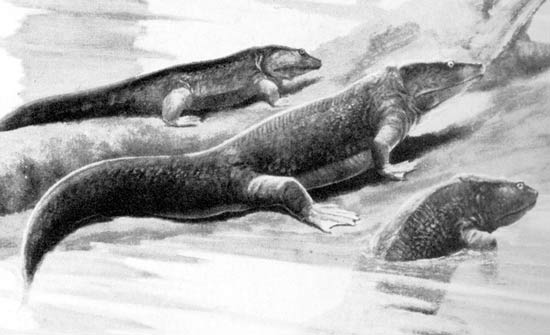The evolutionist scenario further maintains that after a time, fish-which had evolved from invertebrates-developed limbs and turned into amphibians capable of living on dry land. But, as you might imagine, there is no evidence for such a scenario. Not a single fossil of a half-fish, half-amphibian creature has ever been found.
The process of a transition from water to dry land espoused by evolutionists never happened.
In addition to the complete absence of the fossils needed to indicate such a transition, a great many important changes would have had to take place for any living thing to move from water to land. But such a transition is impossible, and many factors make it so. For example, fishes' gills would have to turn into lungs for them to be able to live on land, and their fins would have to strengthen and lengthen into legs. Radical changes would also have to take place in a wide range of internal areas, such as energy consumption and the circulatory and excretory systems. Moreover, all these radical changes would have to take place at once for a creature moving from water to dry land to survive.
But it is doubtlessly impossible for such physiological and anatomical changes to take place by chance and simultaneously. And evolutionists are in fact well aware of these impossibilities.
  |
Hoimar Von Ditfurth is a German professor of neurology and psychiatry and a well-known evolutionist science writer:
As we have seen, life on land is a difficult and wearisome one, constantly raising problems needing to be resolved. In that case one cannot refrain from asking yet again: why, yes why, did we leave the water? The more one ponders this, the less logical this evolutionary step appears, and what happened seems to be an irresoluble puzzle.227
Robert L. Carroll is the author of Vertebrate Paleontology and Evolution:
We have no intermediate fossils between rhipidistian fish and early amphibians.228
Unfortunately, not a single specimen of an appropriate reptilian ancestor is known prior to the appearance of true reptiles. The absence of such ancestral forms leaves many problems of the amphibian-reptilian transition unanswered.229
Edwin H. Colbert is an authority on paleontology and curator at the American Museum of Natural History, and M. Morales is the author of Evolution of the Vertebrates:
There is no evidence of any Paleozoic amphibians combining the characteristics that would be expected in a single common ancestor. The oldest known frogs, salamanders, and caecilians are very similar to their living descendants.230
From the Encyclopedia Britannica:
The origin of this highly successful order is obscured by the lack of early fossils, although turtles leave more and better fossil remains than do other vertebrates... Intermediates between turtles and cotylosaurs... reptiles from which turtles [supposedly] sprang, are entirely lacking.231
Lewis L. Carroll is an evolutionist paleontologist and author of Vertebrate Paleontology and Evolution:
Unfortunately, not a single specimen of an appropriate reptilian ancestor is known prior to the appearance of true reptiles. The absence of such ancestral forms leaves many problems of the amphibian-reptilian transition unanswered.232
Robert L. Carroll is a vertebrate paleontologist and professor of biology at McGill University:
We have no intermediate fossils between rhipidistian fish and early amphibians.233
227- Hoimar Von Ditfurth, Dinozorlar›n Sessiz Gecesi 2, ["The Silent Night of the Dinosaurs 2"] p. 149.
228- Robert L. Carroll, Vertebrate Paleontology and Evolution, New York: W. H. Freeman and Co., 1988, p. 4.
229- Robert L. Carroll, "Problems of the Origin of Reptiles," Biological Reviews of the Cambridge Philosophical Society, Vol. 44, No. 3, July 1969, p. 393.
230- Edwin H. Colbert, M. Morales, Evolution of the Vertebrates, New York: John Wiley and Sons, 1991, p. 99.
231- Encyclopaedia Britannica Online, "Turtle"
232- Lewis L. Carroll, "Problems of the Origin of Reptiles," p. 393.
233- Carroll, Robert L., Vertebrate Paleontology and Evolution, p. 138.